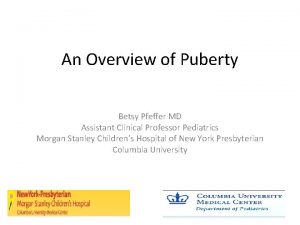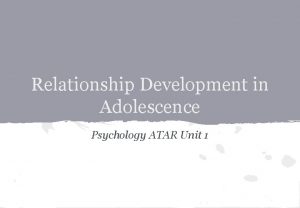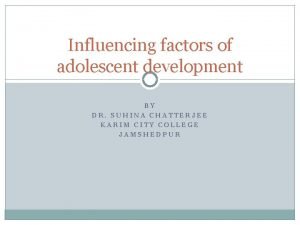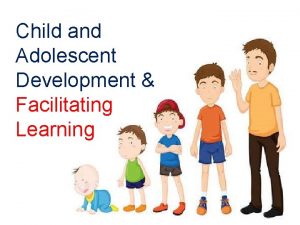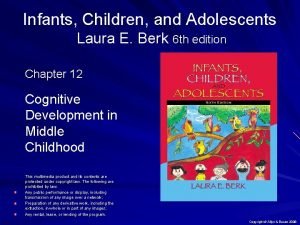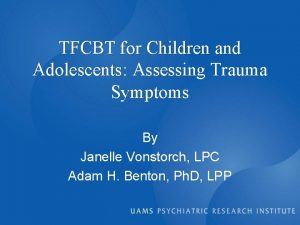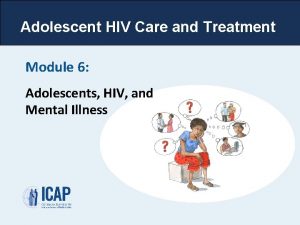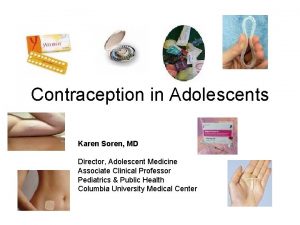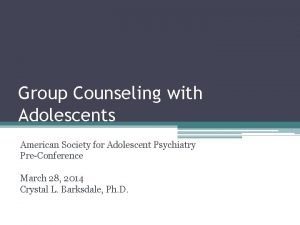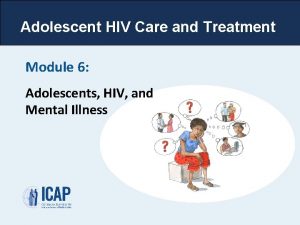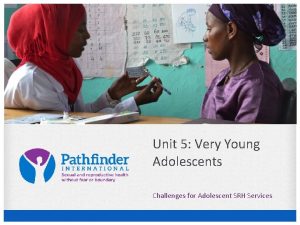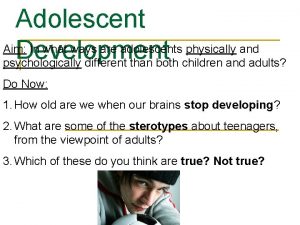Adolescent Development Adolescents are n n Age 10

















- Slides: 17

Adolescent Development

Adolescents are: n n Age: 10 -19 40. 7 million


Adolescents: Increasingly Diverse Source: Fact Sheet on Demographics: Adolescents, National Adolescent Health Information Center, http: //nahic. ucsf. edu//downloads/Demographics. pdf. Accessed: November 29, 2005

Challenge #1 Biological Development Onset of puberty 10 -12 11 -13 Growth spurt 10 -12 12 -14 Early maturation 7

Biological Development Eating Disorders: approx. 1% of girls (12 -18) anorexic 1 -3% bulimic 20% (estimated) engaged in less extreme unhealthy dieting Nutrition: ¾ of adolescents do not eat recommended servings Overweight: ages 12 -19 (1971 – 2002) Boys 6. 1% - 16. 7% Girls 6. 2% - 15. 4% Physical activity level drops dramatically( 9→ 12 grade)

Challenge #2 Cognitive Development Normal adolescent behavior? q q to argue for the sake of arguing to be self- centered to constantly find fault in adult’s position to be overly dramatic YES!

Cognitive Development different arrow 19 years • ability to think abstractly • ability to analyze situations 10 years logically • ability to think realistically about the future, goal setting • moral reasoning • Entertain hypothetical situations, use of metaphors Need guidance for rational decision making

Brain Research Findings The brain continues to develop during adolescence. Areas under construction: • Prefrontal cortex – responsible for organizing, setting priorities, strategizing, controlling impulses • Brain functions that help plan and adapt to the social environment • Brain functions that help put situations into context; retrieve memories to connect with gut reactions

Challenge #3 Social Emotional Development § Who am I? Where do I belong? - Identity development (gender, sexual, ethnic) - Self-esteem - Role of peer group § How do I relate to others? - Social Skills - Emotional Intelligence

Experimenting with Intimacy Romantic Relationship Sexual Experience 12 -14 years - 24% 15 -19 yrs 1995 - 2002 Boys 55. 3% - 46% Girls 51. 7% 46. 8% 15 -17 years – 39% Sexual behavior is changing 15 -19 yrs Oral Sex Boys 55% Girls 54 %

Peer s Environmental Settings Fa m ily School d YOUTH oo h r o b gh Nei Co m Media/ Internet m un ity

Social Toxicity Social factors that poison youth’ well being and healthy development

Risk Taking Behavior? It is normal! - But there is concern – Exploration of new behaviors, decision making skills, identity development Adolescents overestimate their capacities, rely on their immature ability to judge, or give in to peer pressure

Problem Behaviors § § § Teen Pregnancy Violence Delinquency Substance Abuse School drop out Mental health

Positive Youth Outcomes • • Volunteerism Music & Performing Arts High School Graduation Enrollment in College

Main Sources: n National Campaign to Prevent Teen Pregnancy 2005. Freeze Frame: A Snapshot of America’s Teens www. teenpregnancy. org n American Psychological Association 2002. Developing Adolescents. www. apa. org/pi/pii/develop. pdf
 Antigentest åre
Antigentest åre Adolescence ap psychology
Adolescence ap psychology Early adolescent age
Early adolescent age Stone age, bronze age iron age timeline
Stone age, bronze age iron age timeline Iron age bronze age stone age timeline
Iron age bronze age stone age timeline Dunphy's stages of adolescent group development
Dunphy's stages of adolescent group development What factors influence adolescent development
What factors influence adolescent development Scaffold and fade-away technique
Scaffold and fade-away technique Physical development
Physical development Difference between courtship and dating
Difference between courtship and dating Discontinuity of development
Discontinuity of development Lara berk
Lara berk Pre adolescent girl
Pre adolescent girl Challenges of middle and late adolescence
Challenges of middle and late adolescence Undefined status adolescence
Undefined status adolescence Adolescence
Adolescence Erikson stage
Erikson stage Integrity versus despair
Integrity versus despair


